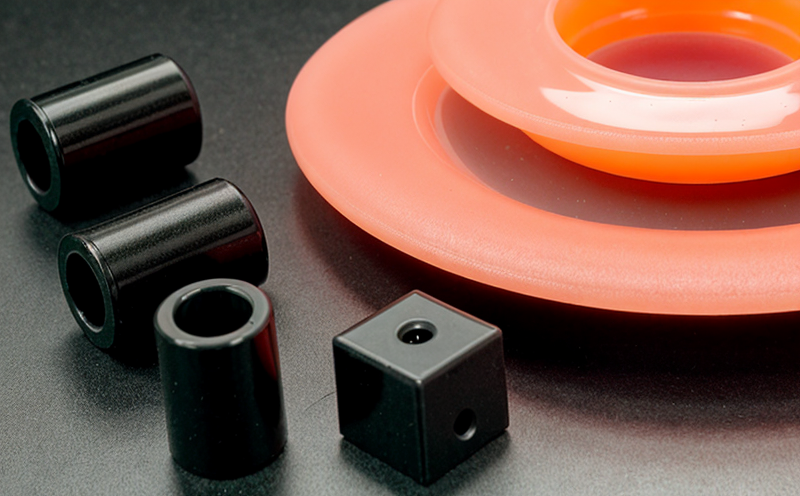UNE EN 12771 Fatigue Testing of Plastic Sports Equipment
The UNE EN 12771 standard is crucial for ensuring that plastic sports equipment withstands the rigorous demands placed upon it during use. This fatigue testing method evaluates how materials and components perform under repeated loading cycles, simulating real-world conditions to identify potential weaknesses or failure points before they become critical issues.
In the realm of sports & leisure plastics testing, fatigue testing is particularly important due to the high stress levels these products endure. For instance, tennis rackets, golf clubs, and soccer balls are all subjected to significant mechanical stresses over time. Ensuring that materials like polyethylene (PE), polystyrene (PS), or acrylonitrile butadiene styrene (ABS) can withstand repeated impacts without compromising performance is essential for maintaining product safety and integrity.
The UNE EN 12771 fatigue testing procedure typically involves the following steps: selecting appropriate specimens, preparing them according to specified dimensions and tolerances, applying cyclic loading at prescribed rates, monitoring deformation patterns, and assessing any signs of failure. Compliance with this standard helps manufacturers meet regulatory requirements while also enhancing brand reputation by demonstrating a commitment to quality.
Understanding the nuances of UNE EN 12771 is vital for those involved in developing or procuring sports equipment. Quality managers must ensure that their suppliers adhere strictly to these guidelines, whereas R&D engineers can use this knowledge to innovate safer, more durable products. For procurement teams, knowing about fatigue testing allows them to specify precise criteria when sourcing components from external vendors.
Let’s delve deeper into the specifics of what UNE EN 12771 entails:
- Type of Testing: This involves subjecting samples to repeated bending or flexing actions until failure occurs. It simulates the cyclic loading conditions that occur during actual use.
- Testing Parameters: Key variables include frequency of load application, maximum stress level, and duration of testing.
- SPECIMEN PREPARATION: Specimens are cut from larger pieces of plastic ensuring they meet the required dimensions specified in UNE EN 12771. Careful preparation is crucial to obtain accurate test results.
The process begins with selecting suitable specimens that represent typical manufacturing variations within a batch. After cutting, these specimens undergo rigorous inspection before being mounted onto testing equipment designed specifically for cyclic loading applications.
Critical aspects of the methodology include:
- Specimen orientation relative to expected loads
- Loading rate control to mimic realistic usage scenarios
- Monitoring displacement and strain during each cycle
Detailed monitoring ensures that even minor deviations from ideal behavior are captured early, allowing for corrective actions if necessary. Once testing is complete, thorough analysis of the results helps determine whether any changes need to be made to improve future iterations.
Applied Standards
| Standard Name | Description | Reference Number |
|---|---|---|
| UNE EN 12771 | Cyclic fatigue testing of plastic materials and components used in sports equipment. | UNE EN 12771:2015 |
The UNE EN 12771 standard sets out comprehensive procedures for cyclic fatigue testing, which is particularly relevant when examining plastic materials intended for use in sports equipment. Compliance with this standard ensures that manufacturers produce products capable of enduring repeated loading cycles without exhibiting signs of distress.
By adhering to these stringent specifications, companies can enhance the reliability and longevity of their offerings, thereby fostering trust among consumers who rely on high-quality athletic gear. Furthermore, compliance with UNE EN 12771 helps manufacturers avoid costly recalls or legal issues associated with substandard products.
Scope and Methodology
The scope of UNE EN 12771 extends beyond simple tensile strength measurements. Instead, it focuses on evaluating the fatigue resistance of plastic components used in sports equipment under specific loading conditions. This involves subjecting specimens to repeated bending or flexing actions until failure occurs.
Testing parameters such as frequency of load application, maximum stress level, and duration of testing play a crucial role in determining how well materials perform over extended periods. Specimens are carefully prepared according to strict guidelines provided within the standard before being mounted on specialized fatigue testing machines capable of applying cyclic loads accurately.
The methodology includes:
- Specimen preparation ensuring they meet required dimensions
- Loading rate control to simulate realistic usage scenarios
- Monitoring displacement and strain during each cycle
Detailed monitoring ensures that even minor deviations from ideal behavior are captured early, allowing for corrective actions if necessary. Once testing is complete, thorough analysis of the results helps determine whether any changes need to be made to improve future iterations.
This approach not only enhances product performance but also contributes significantly towards safety standards in sports and leisure industries. By rigorously assessing fatigue resistance early in development stages, manufacturers can identify potential weaknesses before they become critical issues leading to failures during actual use.
Quality and Reliability Assurance
- Cyclic Load Testing: Ensures that materials endure repeated loading cycles without exhibiting signs of distress.
- SPECIMEN PREPARATION: Specimens are cut to precise dimensions ensuring they represent typical manufacturing variations within a batch.
- Loading Rate Control: Maintains consistency in applying loads, simulating realistic usage scenarios accurately.
Quality assurance is integral to maintaining the integrity of UNE EN 12771 compliance. By adhering strictly to these procedures, manufacturers can ensure that their products meet stringent fatigue resistance requirements set forth by international standards. This commitment enhances product reliability and fosters trust among consumers who rely on high-quality athletic gear.
Reliability assurance further strengthens the foundation of compliant testing practices through continuous improvement initiatives aimed at identifying areas for enhancement within existing methodologies. Regular updates based on feedback from users help maintain relevance in an ever-evolving industry landscape.





